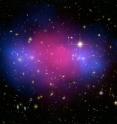Hubble and Chandra composite of the galaxy cluster MACS J0025.4-1222
Related images
(click to enlarge)
New Hubble and Chandra observations of the cluster known as MACSJ0025.4-1222 indicate that a titanic collision has separated dark from ordinary matter. This provides independent confirmation of a similar effect detected previously in a target dubbed the Bullet Cluster, showing that the Bullet Cluster is not an anomalous case. MACSJ0025 formed after an enormously energetic collision between two large clusters. Using visible-light images from Hubble, astronomers were able to infer the total mass distribution — dark and ordinary matter. Hubble was used to map the dark matter (coloured in blue) using a technique known as gravitational lensing. Chandra data enabled the astronomers to accurately map the ordinary matter, mostly in the form of hot gas, which glows brightly in X-rays (shown in pink).
As the two clusters that formed MACSJ0025 (each almost a whopping quadrillion times the mass of our Sun) merged at speeds of millions of kilometres per hour, hot gas in the two clusters collided and slowed down, but the dark matter passed right through this smash-up. The separation between material shown in pink and blue therefore provides observational evidence for dark matter and supports the view that dark matter particles interact with each other only very weakly or not at all, apart from the pull of gravity.
Source: ESA/Hubble Information Centre
Articles on the same topic
- Collision of galaxy clusters captured by astronomersWed, 27 Aug 2008, 18:28:28 UTC
- A clash of clusters provides another clue to dark matterWed, 27 Aug 2008, 15:36:35 UTC
- How do galaxies grow?Tue, 26 Aug 2008, 14:15:25 UTC
Other sources
- Colliding galaxies shed light on dark matterfrom Reuters:ScienceWed, 27 Aug 2008, 23:00:08 UTC
- Powerful Cosmic Collision Creates Divorce of Matterfrom Space.comWed, 27 Aug 2008, 20:28:06 UTC
- PHOTO IN THE NEWS: Cluster Smashup Is Dark Matter Prooffrom National GeographicWed, 27 Aug 2008, 18:49:05 UTC
- Collision of galaxy clusters captured by astronomersfrom Science BlogWed, 27 Aug 2008, 18:28:07 UTC
- SPACE PHOTOS THIS WEEK: Massive Galaxy Cluster, Morefrom National GeographicWed, 27 Aug 2008, 17:42:04 UTC
- Galaxy Surprise Sheds Light on Dark Matterfrom Space.comWed, 27 Aug 2008, 17:07:09 UTC
- A Clash of Clusters Provides Another Clue to Dark Matterfrom Newswise - ScinewsWed, 27 Aug 2008, 15:35:28 UTC
- A clash of clusters provides another clue to dark matterfrom PhysorgWed, 27 Aug 2008, 15:35:23 UTC
- Clash Of Clusters Provides New Dark Matter Cluefrom Science DailyWed, 27 Aug 2008, 15:35:06 UTC
- A Clash of Clusters Provides New Clue to Dark Matterfrom Newswise - ScinewsWed, 27 Aug 2008, 14:28:12 UTC
- How Do Galaxies Grow? Massive Galaxies Caught In The Act Of Mergingfrom Science DailyTue, 26 Aug 2008, 13:21:10 UTC
- Giant cluster of galaxies is discoveredfrom UPIMon, 25 Aug 2008, 19:56:11 UTC
- XMM-Newton's massive discoveryfrom PhysorgMon, 25 Aug 2008, 18:14:23 UTC
- Giant Galaxy Cluster Seen in Early Universefrom Space.comMon, 25 Aug 2008, 16:21:22 UTC
- Giant Galaxy Cluster Seen in Early Universefrom Live ScienceMon, 25 Aug 2008, 16:21:15 UTC
- XMM-Newton’s massive discoveryfrom European Space AgencyMon, 25 Aug 2008, 8:07:17 UTC
